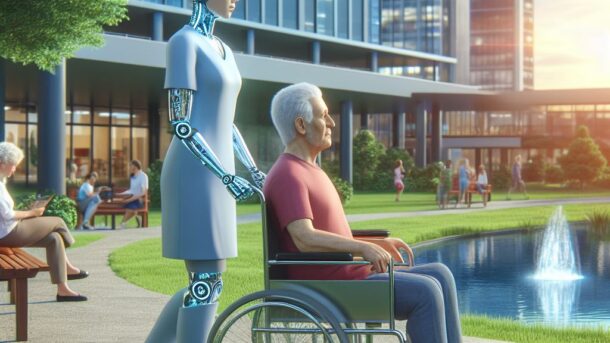Artificial Intelligence (AI) is becoming an engine of change in our rapidly changing technological landscape, with the potential to revolutionise many aspects of our lives. Improving the lives of people with disabilities is one area where artificial intelligence (AI) has the potential to have a significant impact. Artificial Intelligence (AI) creates new opportunities for access, inclusion, and independence by using the power of advanced algorithms and machine learning. As with any transformative technology, though, it’s important to weigh the possible advantages and disadvantages carefully.
Communication Breakthrough
Individuals with speech or hearing impairments may struggle to communicate. AI-powered assistants, such as Google Voice Access and Live Transcribe, are breaking down these barriers. In the United Kingdom, the National Health Service has introduced AI transcription tools in hospitals to help patients with hearing loss. Similarly, Australia has implemented AI captioning in parliament to improve accessibility.
Redefining Mobility
Mobility is an essential part of daily life, and those with physical disabilities may find it difficult to navigate the world. AI-powered technologies, such as the WHILL autonomous wheelchair developed in Japan, use sensors and navigation systems to autonomously navigate environments, reducing physical strain and increasing freedom of movement.
AI-powered navigation apps, such as Mapability and AccessMap, have been adopted by a number of European cities, offering customised routing according to accessibility specifications. However, if routing avoids specific areas, concerns have been raised regarding data privacy and potential discrimination.
Help for Smart Homes
AI has the power to completely transform everyday assistive technologies. With the use of voice commands or gesture recognition, smart home devices like Apple’s HomeKit and Amazon’s Alexa can automate household chores and increase the independence of people with disabilities. Businesses such as Microsoft and Google are creating AI-driven prompting systems to assist people with cognitive impairments with everyday tasks.
However, some people may find the cost of these systems prohibitive, and there have been worries expressed regarding possible privacy violations or hacking.
All-Inclusive Education
Countries like Singapore and Finland are leading the way in the development of AI-powered tutoring systems that can adjust to each student’s unique learning needs and styles. AI is revolutionising education. With the help of these systems, which can pinpoint problem areas and modify curricula accordingly, students with disabilities can receive individualised instruction.
Critics caution that although AI seems promising, it may contain biases that, if left unchecked, could exacerbate already-existing inequalities.
Improving Medical Care
Early detection and individualised treatment plans are already possible thanks to AI in healthcare. DeepMind’s AI system has improved the accuracy of eye disease diagnosis in the UK. AI-driven robotic systems, such as those made by Rewalk Robotics, are helping with physical rehabilitation in the United States.However, there are issues with AI diagnosis transparency and accuracy, as well as the possibility for job displacement in the healthcare field if AI systems become too advanced.
Opportunities for Employment.
To link people with disabilities to appropriate employment opportunities, nations like Germany and Japan are investigating AI-driven job-matching algorithms. Artificial intelligence (AI)-driven assistive technologies, such as speech recognition software from businesses like Nuance, can improve workplace efficiency and accommodate a range of abilities.
Though some worry that if AI is not used carefully, it could result in discrimination or job losses, its effects on the labour market are mixed.
Moral Aspects to Take into Account
Ensuring accessibility and addressing ethical issues are critical as AI becomes more commonplace. Guidelines for trustworthy AI have been introduced by the European Union, emphasising values such as equality, openness, and non-discrimination. Enforcing these rules and navigating the intricate ethical environments surrounding AI, however, continue to be very difficult tasks.
Conclusion
Though it’s a two-edged sword, artificial intelligence has enormous potential to empower people with disabilities. While AI has the potential to create opportunities and foster inclusivity, if it is not developed and applied responsibly, it also runs the risk of sustaining prejudices, jeopardising privacy, and eliminating jobs.
Prioritising ethical issues, and encouraging cooperation between developers, disability advocates, and legislators are crucial as we embrace this game-changing technology and make sure AI continues to be a force for good, leaving no one behind.
To fully utilise AI’s potential and minimise its risks, governments, businesses, and society as a whole must collaborate. Only then can we hope to build a future in which accessibility and inclusion are ingrained in our daily lives rather than merely being ideals?




